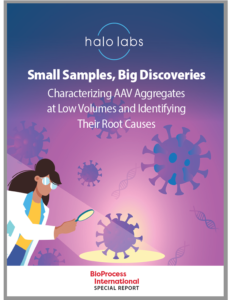- Sponsored Content
- Gene Therapies
Small Samples, Big Discoveries: Characterizing AAV Aggregates at Low Volumes and Identifying Their Root CausesSmall Samples, Big Discoveries: Characterizing AAV Aggregates at Low Volumes and Identifying Their Root Causes
Sponsored by Halo Labs
 Gene therapies that use AAVs have shown great promise, but can be unstable due to their fragile composite DNA/protein nature, which presents an analytical challenge when determining root cause of subvisible particle (SVP) formation and product instability.
Gene therapies that use AAVs have shown great promise, but can be unstable due to their fragile composite DNA/protein nature, which presents an analytical challenge when determining root cause of subvisible particle (SVP) formation and product instability.
Understanding how these proteins interact with leaked payloads will allow better insight into avoiding aggregate buildup. Yet, this has been difficult, hampered by legacy systems that cannot conduct low volume SVP analysis or interrogate for DNA content.
That’s about to change.
In one 5µL assay, Aura GT can quantify capsid aggregates, distinguish them from protein aggregates, and detect DNA leakage from unstable AAV capsids. Powered by Fluorescence Membrane Microscopy, helps monitor nucleic acid leakage that can occur under common storage conditions which often leads to AAV aggregation. Aura GT provides a low-volume, high-throughput, and sensitive methodology for comprehensive AAV formulation development, enabling characterization of subvisible particles and their formation, as well as the impact of DNA leakage on sample stability in early phase development.
Fill out the form below to download the full report from Halo Labs.
You May Also Like






